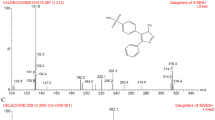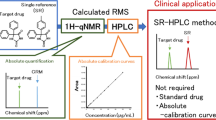Abstract
Parecoxib is the injectable prodrug of valdecoxib, a cicloxygenase-2 selective drug, currently used in human medicine. Recent studies have suggested both its excellent clinical effectiveness and wide safety profile. The aim of the present study was to develop and validate a new high-performance liquid chromatography (HPLC) with spectrofluorimetric detection method to quantify parecoxib and valdecoxib in canine plasma. Several parameters both in the extraction and the detection method were evaluated. The applicability of the method was determined by administering parecoxib to one dog: the protocol provided the expected pharmacokinetic results. The final mobile phase was acetonitrile: AcONH4 (10 mM; pH 5.0) 55:45, v/v, with a flow rate of 0.4 mL min−1, and excitation and emission wavelengths of 265 and 375 nm, respectively. The analytical column was a reverse-phase C18 ODS2 3-μm particle size. Protein precipitation in acidic medium followed by two successive liquid–liquid steps was carried out. The best extraction solvent was cyclohexane:Et2O (3:2, v/v) that gave recoveries ranging from 81.1% to 89.1% and from 94.8% to 103.6% for parecoxib and valdecoxib, respectively. The limits of quantification were 25 and 10 ng mL−1 for parecoxib and valdecoxib, respectively. The chromatographic runs were specific with no interfering peaks at the retention times of the analytes, as confirmed by HPLC–mass spectrometry experiments. The other validation parameters were in agreement with the European Medicines Evaluation Agency and International Conference on Harmonisation guidelines. In conclusion, this method (extraction, separation and applied techniques) is simple and effective. This is the first time that use of a HPLC with spectrofluorimetric detection technique to simultaneously detect parecoxib and valdecoxib in plasma has been reported. This technique may have applications for pharmacokinetic studies.

In vivo metabolism of the prodrug parecoxib in the active ingredient valdecoxib







Similar content being viewed by others
Abbreviations
- CX:
-
Celecoxib
- DFU:
-
[5,5-Dimethyl-3-(3-fluorophenyl)-4-(4-methylsulphonyl)phenyl-2(5H)-furanone]
- PX:
-
Parecoxib
- RX:
-
Rofecoxib
- VX:
-
Valdecoxib
References
Talley JJ, Brown DL, Carter JS, Graneto MJ, Koboldt CM, Masferrer JL, Perkins WE, Rogers RS, Shaffer AF, Zhang YY, Zweifel BS, Seibert KJ (2000) Med Chem 43:1661–1663
Lloyd R, Derry S, Moore RA, McQuay HJC (2010) Cochrane Collab 15:1–40
Dalpiaz AS, Peterson D (2004) Expert Rev Neurother 4:165–177
Luscombe KS, McDonnell NJ, Muchatuta NA, Paech MJ, Nathan EA (2010) Anaesth Intensive Care 38:141–148
Xu LL, Shen JJ, Zhou HY (2010) Chin J Cardiol 90:1893–1896
Wang Q, Li Z, Wang ZP, Cui C (2010) Nan Fang Yi Ke Da Xue Xue Bao 30:2556–2557
Jin L, Long-nian J, Xue-mei Z, Ru-quan H (2010) Chin J Anesth 30:29–32
Shu-juan J, Feng Z, Li-bing H, Su-yang C (2010) Shiyong Pharm Clin Remed 13:16–17
Buschmann HH, Sola Carandell L, Benet Buchholz J, Ceron B, Jordi C (2010) PCT Int Appl WO 2010043412 A1 20100422
Pearlman R, Jenkins H, Serafini T (2010) PCT Int Appl WO 2010071866 A2 20100624
Schultz JR, Vollrath B, Turner C (2010) PCT Int Appl WO 2010065491 A2 20100610
Buerger E (2010) PCT Int Appl WO 2010010136 A1 20100128
Schröder H, Höllt V, Becker A (2011) Neurochem Int 58:9–13
Kongara K, Chambers JP, Johnson CB (2010) Res Vet Sci 88:127–133
Kongara K, Chambers JP, Johnson CB (2009) Vet Anaesth Analg 36:86–94
Pozzobon R, Brass KE, De La Corte FD, Silveira EA, Abreu HC (2008) Arq Bras Med Vet Zootec 60:806–814
Shaikh SMT, Manjunatha DH, Seetharamappa J, Kandagal PB (2007) Anal Lett 40:2925–2934
Pavan Kumar VV, Vinu MC, Ramani AV, Mullangi R, Srinivas NR (2006) Biomed Chromatogr 20:125
Sane RT, Menon S, Desphande AY, Jain A (2005) Chromatographia 61:137–141
Ramakrishna NVS, Vishwottam KN, Wishu S, Koteshwara M (2004) J Chrom B 802:271–275
Keshetty S, Venisetty RK, Molmoori V, Ciddi V (2006) Pharmazie 61:245–246
Rao RN, Meena S, Nagaraju D, Rao AR (2005) Biomed Chromatogr 10:362–368
Werner U, Werner D, Hinz B, Lambrecht C, Brune K (2005) Biomed Chromatogr 10:113–118
Zhang JY, Yuan JJ, Wang YF, Bible RH, Breau AP (2003) Drug Metab Dispos 31:491–501
Anonymous (2009) EMEA/CHMP/EWP/192217/2009
Anonymous (1996) Guidelines for validation of analytical procedures: methodology—International Conference of Harmonization of Technical Requirements for Registration of Pharmaceutical for Human Use
Yamaoka K, Terumichi N, Uno T (1978) J Pharmacokinet Biopharm 6:165–175
Gibaldi M, Perrier D (1982) Pharmacokinetics, 2nd edn. Marcel Dekker, New York
Starek M, Krzek J, Dechnik J (2009) J Anal Chem 64:621–623
Shehata MA, Hassan NY, Fayed AS, El-Zeany BA (2004) Il Farmaco 59:139–145
Acknowledgements
None of the authors has any financial or personal relationships that could inappropriately influence or bias the content of the paper. The authors wish to thank Pfizer (Groton, CT, USA) for supplying pure analytical standards of PX and VX. The manufacturer of the agents under review was offered an opportunity to comment on this article. No comment was received concerning the scientific and editorial merit of the manuscript. This work was supported by athenaeum funds (ex 60% University of Pisa). The preparation of manuscript was not supported by any external funding. Authors acknowledged to Dr E. Owen (University of Queensland, Australia) the English editing of the manuscript.
Author information
Authors and Affiliations
Corresponding author
Additional information
G. Saccomanni and M. Giorgi have equally contributed to the study.
Rights and permissions
About this article
Cite this article
Saccomanni, G., Giorgi, M., Del Carlo, S. et al. Simultaneous detection and quantification of parecoxib and valdecoxib in canine plasma by HPLC with spectrofluorimetric detection: development and validation of a new methodology. Anal Bioanal Chem 401, 1677–1684 (2011). https://doi.org/10.1007/s00216-011-5244-4
Received:
Revised:
Accepted:
Published:
Issue Date:
DOI: https://doi.org/10.1007/s00216-011-5244-4




